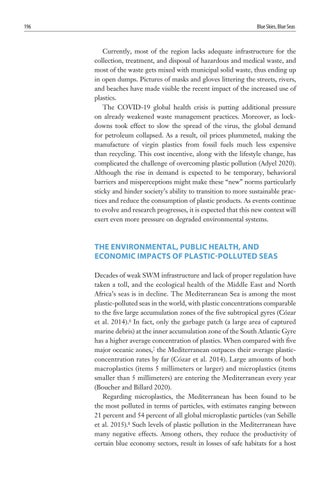196
Blue Skies, Blue Seas
Currently, most of the region lacks adequate infrastructure for the collection, treatment, and disposal of hazardous and medical waste, and most of the waste gets mixed with municipal solid waste, thus ending up in open dumps. Pictures of masks and gloves littering the streets, rivers, and beaches have made visible the recent impact of the increased use of plastics. The COVID-19 global health crisis is putting additional pressure on already weakened waste management practices. Moreover, as lockdowns took effect to slow the spread of the virus, the global demand for petroleum collapsed. As a result, oil prices plummeted, making the manufacture of virgin plastics from fossil fuels much less expensive than recycling. This cost incentive, along with the lifestyle change, has complicated the challenge of overcoming plastic pollution (Adyel 2020). Although the rise in demand is expected to be temporary, behavioral barriers and misperceptions might make these “new” norms particularly sticky and hinder society’s ability to transition to more sustainable practices and reduce the consumption of plastic products. As events continue to evolve and research progresses, it is expected that this new context will exert even more pressure on degraded environmental systems.
THE ENVIRONMENTAL, PUBLIC HEALTH, AND ECONOMIC IMPACTS OF PLASTIC-POLLUTED SEAS Decades of weak SWM infrastructure and lack of proper regulation have taken a toll, and the ecological health of the Middle East and North Africa’s seas is in decline. The Mediterranean Sea is among the most plastic-polluted seas in the world, with plastic concentrations comparable to the five large accumulation zones of the five subtropical gyres (Cózar et al. 2014).6 In fact, only the garbage patch (a large area of captured marine debris) at the inner accumulation zone of the South Atlantic Gyre has a higher average concentration of plastics. When compared with five major oceanic zones,7 the Mediterranean outpaces their average plasticconcentration rates by far (Cózar et al. 2014). Large amounts of both macroplastics (items 5 millimeters or larger) and microplastics (items smaller than 5 millimeters) are entering the Mediterranean every year (Boucher and Billard 2020). Regarding microplastics, the Mediterranean has been found to be the most polluted in terms of particles, with estimates ranging between 21 percent and 54 percent of all global microplastic particles (van Sebille et al. 2015).8 Such levels of plastic pollution in the Mediterranean have many negative effects. Among others, they reduce the productivity of certain blue economy sectors, result in losses of safe habitats for a host






